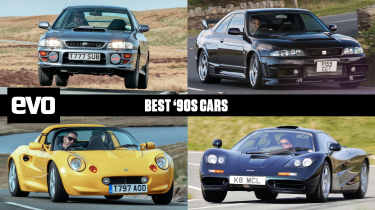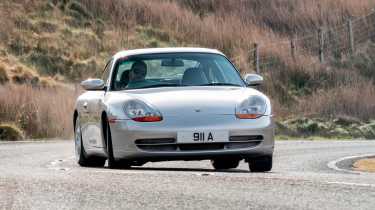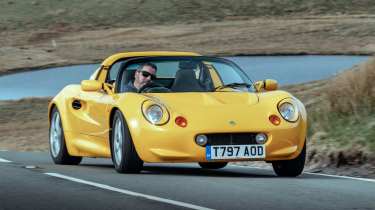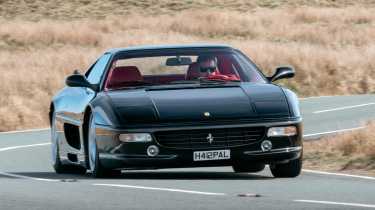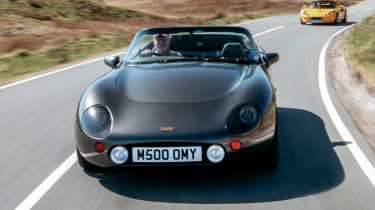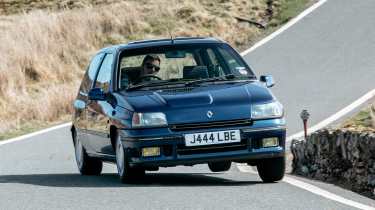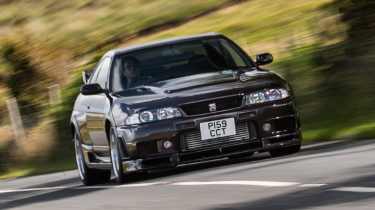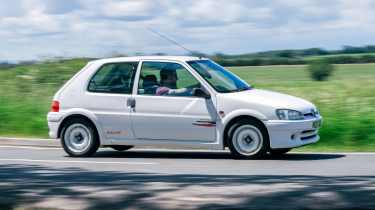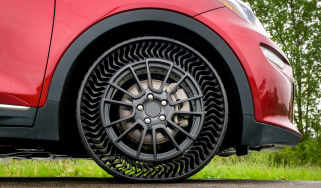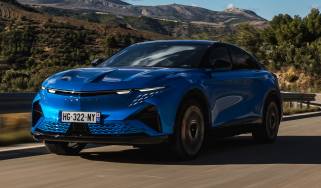Best cars of the 1990s – the ultimate driver’s cars from three decades ago
The 1990s was a goldilocks decade in some ways – new technologies married old-school sensibilities in sensational driver’s cars
The transition from the 1980s to the 1990s was quite dramatic in the world of performance cars, whether talking about powertrains, dynamics, or indeed styling sensibilities. Certainly it was an era where performance cars felt the increasing influence of computer technology, from how engine performance and efficiency is managed, to the growing use of active chassis systems and aerodynamics. But still the grip of emissions and safety regulations had not yet tightened to the extent we saw during subsequent decades.
The groundswell of demand for performance cars in the 1980s had grown into a tidal surge in the 1990s, too. All of this manifested a decade of increased performance without sacrificing engagement. The extroversion of the ’80s subsided too, with the ’90s turning out to be a decade of cars that aged only due to their technology and diminutive proportions, rather than controversial or vestigial designs. Including the selection of machines featured in our evo Eras: 1990s test, we pick our favourite cars of the decade, with a few commiserative mentions at the bottom.
Best 1990s cars
- Porsche 996 Carrera
- Lotus Elise S1
- Subaru Impreza RB5
- Ferrari F355
- TVR Griffith
- Renault Clio 16V
- McLaren F1
- Honda NSX
- Nissan Skyline GT-R Nismo 400R
- Peugeot 106 Rallye
Porsche 996 Carrera (1997 - 2004)
The 1990s are sometimes referred to as the decade of change and no car better exemplifies that than the control car of our Eras tests, the Porsche 911. Where the 3.2 Carrera we featured in our ’80s test was more or less a 911 like any other, the 996 Carrera ripped up the rulebook and started again. Yes it was still rear-engined and yes that engine was still a flat-six, but it was all new and (controversially) fully water-cooled after three decades of air cooling.
> Porsche 911 Carrera (996, 1997-2005) review – an evo Car of the Year champion for under £20k
The 996 was obviously larger than the 993 it replaced, whose platform’s origins go back to the early 1960s, but it was lighter, stiffer and safer and thanks to that platform and the extra power, faster and more capable. In certain aspects, some of the idiosyncrasies of the more old school 911 driving experience and some of the granular feel that the 996 lost are what the more neurotic air-cooled evangelists have a point about, but there’s not much the 996 didn’t objectively improve upon. Except maybe its slippery stretched-out design, though even its looks have matured nicely over the years.
‘It’s the eternal 911 conundrum, that each generation brings quantifiable objective improvements, yet also a yearning for its rawer, quirkier, more distinctive predecessors, a sense that something has been lost.
'In our ’80s test the Carrera had proved to be 911 turned up to 11; the 996 is a lot more civilised, a little less of the gentleman-racer’s road car, a little more executive play-thing. But the core appeal remains. Its body control over sometimes tricky crests and compressions is just superb. It’s immensely satisfying to stroke it along. The weight shifting and all those other evocative 911 tells are still there. It’s still a great car.’ – Peter Tomalin, evo contributor, who tested the 996 against other icons of the 1990s.
Lotus Elise S1 (1996 - 2001)
It’s rare that a car comes along that entirely fits the image and positioning around which the company was originally founded decades earlier, or the ethos by which its founder always swore. Yet the Lotus Elise of 1996 is probably alongside the original Elan, the most ‘Lotus’ any of Hethel’s cars has ever been. It’s four-wheeled embodiment of Colin Chapman’s old ‘simplify and add lightness’ mantra. Innovative yet simple, the Elise with its extruded aluminum underpinnings, lightweight constitution and diminutive proportions, took the sports car genre by storm on its arrival in 1996.
> Used Lotus Elise (S1, 1996-2001) review – a world-beating sports car for supermini money
Driving one brings into sharp focus the exact benefits and opportunities that come with a low kerb weight. It breathes with the road rather than pummels it. It’s quick to respond to your inputs. Every control is perfectly weighted and ratiod. There’s no sense that an attribute has had to be engineered into its behaviour to compensate for something. It feels like it’s so close to the car its creators wanted it to be, which is all too uncommon in this industry, especially today. It’s a car from which so many can and still do, learn so much – an example set, a standard and benchmark by which others are judged and measured.
‘Nothing else feels like an Elise. It’s the sense of gliding across the road surface and yet being in intimate touch with it, feeling every change of road texture but without it intruding or distracting, absolutely minimal inertia when it comes to direction changes, and the eager response to the throttle, making every horsepower count.’ – Peter Tomalin, evo contributor, who tested the Series 1 Lotus Elise on the road in the UK.
Subaru Impreza RB5 (1999)
If the Quattro was the rally star (among many) of the 1980s, the 1990s were basically defined by Subaru and its war with Mitsubishi, both on the special stages and on the road. It was an almost tribal opposition that like the best rivalries, inspired great escalation. The Impreza 22B probably is the best manifestation of that. But the best Impreza as an all-rounder and one with almost as much rally heritage? That’s the RB5 – a 444-off limited edition celebrating Richard Burns’ return to Subaru’s rally team.
> Subaru Impreza RB5 (1999) review – limited-run rally special is still a riot today
The joy of the RB5 is in how it surges down the road, the torque of that boxer four pumelling rotation through all four drive shafts. In the ’90s there wasn’t much that could leave it behind down a properly technical piece of road. The rest of the car matches the shove too. From the steering to the gear shift, it’s a car whose rate of response betrays its age. Its gait is thoroughly contemporary, yet there is an exploitable balance if you push on. This kind of tractability and agility from all-wheel drive rather than ham-fisted understeer-prone raw traction, influenced today’s systems in terms of the kind of driving characteristics they’re designed to cultivate. More than a part of the fabric of car culture in the 1990s, the Impreza is technically still incredibly impressive.
‘The car it brings to mind straight away is the GR Yaris. It has that same feeling of security and mechanical toughness, and I was shocked at how hard you can push it. It just seems to demand more and more commitment. You need to time your throttle inputs to hit the boost when you want it, but once you’re in a rhythm you can cover ground at an amazing rate. For me, it’s everything you want a rally-inspired road car to be.’ – Yousuf Ashraf, evo senior staff writer, who tested the Subaru Impreza RB5 on the road in the UK.
Ferrari 355 (1994 - 1999)
The brightest days in Maranello were still a few years away in the early 1990s. Life was hard on the race track as McLaren, Williams and even Benetton enjoyed the successes the Scuderia came so close to with the 640 in 1989. On the road, the cars were getting tired, the quality wasn’t good enough and the performance just wasn’t there.
> Used Ferrari F355 (1994 - 1999) review – a modern classic supercar for BMW M3 money
New boss Luca di Montezemolo, who had joined as president of Ferrari in November of 1991, was far from impressed and set about instituting an overhaul. We all know what happened a decade later in F1 and we all know how great the road cars became. That started with the Ferrari 355, the rejuvenated, enlivened replacement for the slightly limp 348. The 355 was prettier, faster, more exciting (hello 8500rpm redline thanks to those five-valve heads), better to drive , easier to drive whether dawdling or at speed and crucially, better made and more reliable. It was as if a 348 had been taken on the six-month crash course Hollywood actors take to become Marvel super heroes. The fundamentals are similar to what came before but it was a total, almost unrecognisable transformation in all the ways that matter.
‘The first thing that strikes you is how supple it is, and how easy it is to drive. I expected it to be hard work at low speed but the steering is light and easy, the gearshift isn’t a chore and the engine is wonderfully smooth. It feels wide but I don’t see why you couldn’t use it regularly – that’d be an absolute joy.’ – Yousuf Ashraf, evo senior staff writer, who tested a manual Ferrari F355 on the road in the UK.
TVR Griffith (1990 - 2002)
It would be a mistake to assume the 1990s were wholly a decade of technological advancement when it comes to cars, especially the very best cars. TVR were among the champions of taking barn door engineering, refining it and creating a near inimitably desirable sports car that could genuinely stand comparison with a Porsche 911. Well, a 993 at least. The Griffith featured a contemporary curvaceous design, calling upon 1960s influences in the face of the hard straight lines of the 1990s. Its curved fibreglass skin clothed a tubular steel chassis, its sculpted bonnet covering what at the time was a fairly ubiquitous Rover alloy V8.
> TVR Griffith (1990 - 2002) – Britain’s ‘anti-Porsche’ was a raw sports car
There were no adaptive dampers, no traction control, no ABS, no power steering on early cars and no clever torque-distributing AWD system. It’s a mechanical sports car you have to scruff and get the measure of – that darty nose is sometimes at odds with an occasionally floaty rear end. In other words, it’s the kind of sports car that the 1990s marked the beginning of the end of, as weights, sizes and levels of technical appointment began to increase inexorably.
‘Reduce your inputs and you start to get into more of a flow, the TVR finding plenty of grip as you feed in the power through a corner. The chassis has pretty decent composure, although sharp compressions and crests can catch out the damping: there’s not the same tight control that an Elise has, though of course the extra weight plays a part here too.’ – Yousuf Ashraf, evo senior staff writer, who tested a Griffith on the road in the UK.
Renault Clio 16V (1991 - 1995)
‘But what about the Williams!’ we hear you cry. Like GTi and Rallye in Peugeot world, it’s good to celebrate the underdog model every now and again and the Clio 16V possesses the fundamentals upon which the Williams built. Under the bonnet was a 1.8-litre free-breathing four-cylinder engine with four valves per cylinder, delivering 137bhp at 6500rpm and 119lb ft at 4250rpm, shifting just 1039kg along briskly enough, allowing 0-62mph in 7.7sec and a 127mph top speed. In other words, the 16V by today’s definition, let alone that of the early ’90s, is a feisty hot hatch.
> Renault Clio 16V (Mk1, 1991 - 1995) review, history and specs – an unsung hot hatch hero
To dive it’s a little more composed and grown up than a Peugeot 205 GTI but then, that’s not difficult. It rolls less, it’s more refined, its limits are higher and clearly telegraphed and it’s easy to manipulate, responding to attitude adjustments through the brakes and the steering with clarity. This is the Rosetta Stone for the small hot Renaults we came to love in the late 1990s and the 2000s – it set the mold.
‘It’s really good fun, a proper terrier of a car. It sometimes feels like you’re over-driving it, but that’s how it wants to be driven.’ – John Barker, evo editor-at-large, who tested the Renault Clio 16V on the road in the UK.
McLaren F1 (1993 - 1998)
It doesn’t really need much explanation or introduction, does it? Everything there is to know about the McLaren F1 is already known, repeated ad absurdum. What’s important about it in the context of this list is not that it is one of the best cars of the ’90s, but what it typified of this era. We’ll repeat it again, technology in terms of materials, manufacturing techniques, computers and powertrain engineering was lunging forward day by day. As was our understanding of aerodynamics, driving dynamics and so on. Take all this as well as one of the great modern engineering minds of any field, apply a no-compromise ultimate road car ethos and it’s almost a given, you get the likes of the F1.
> McLaren F1 (1994 - 1998): driving the 240mph hypercar icon
So giant were the leaps forward it took in terms of its powertrain, aerodynamics, material use, packaging and overall design, that the records it broke were almost a matter of course. It was a signpost of what was possible, with the kinds of tools that were being created, the kinds of technologies being developed and explored in a decade that was all about progress. Yet because it was also a decade that predated obsessive, excessive regulation as well as the kind of insatiable hunger for performance and extroversion we have today, the F1 is a delicate and elegant, yet visceral driving experience. It’s extreme yes, but an excercise in deft balance in the extreme, rather than an unmitigated glut of top trump numbers. In many ways, it remains an unsurpassed peak in motoring.
‘Sweeping out on a wide line through the last corner, brushing the concrete kerb on the inside, you can feel its gentle ridges in detail through the rim of the steering wheel, and that’s followed by the crinkle-cut surface and the vein-like joints between the concrete sections of the runway on the exit. This is the car wrought as an instrument, a precision instrument.’ – John Barker, evo editor-at-large, who tested the McLaren F1 in period and revisited the car latterly.
Nissan Skyline GT-R Nismo 400R (1997)
If the NSX took a very efficient, tight-tolerance Japanese approach to existing ideas, the Nissan Skyline GT-R blew up the establishment with formulae not yet seen. Well, not really – do you count the Audi Quattro a spiritual predecessor to the R32 GT-R? I didn’t think so. No, these monstrous machines were at their core fairly humdrum saloons turned into rocketships with an arsenal of bleeding edge tech. Sophisticated rear-biased ATTESA all-wheel drive, HICAS rear-wheel steering, sophisticated twin-turbocharged six-cylinder engines. On the race track, the GT-R turned touring car and GT racing on its head to an extent that the Nissan’s were largely ostracised through regulation changes.
> Nissan Skyline GT-R Nismo 400R (1997) review – the JDM icon with a hypercar price
The Skyline GT-R is multi-generational, spanning the 1990s. Arguably the R33 Nismo 400R was the GT-R at its peak, in the 1990s at least. This was a no holds barred GT-R – liberal use of carbonfibre in the bodywork, Bilstein dampers, increased spring rates, a titanium strut brace and much more. The star of the show though is the RB-X GT2 engine – a 2.8-litre twin-turbo straight straight-six built by the same bods that prepared Nissan’s Group A race engines, good for 395bhp (not very gentleman’s agreement-ey, eh?) and 347lb ft. The result was the tightest, tautest, most engrossing Skyline of them all, perhaps south of the R34 Z-Tune of 2005. It’s a unicorn – just 44 were made and each are now worth over £1m.
‘It’s a cool evening and the engine seems hungrier than ever for the dense air, the steering shimmies and wriggles over the worst bumps but is full of feel, and I manage to get the 400R in that sweet spot where it locks into corners on entry but floats out of them just on the edge of oversteer without tipping over into a clumsy slide. It feels sensational, a compelling mix of heavyweight engineering and lithe responses with a unique soundtrack and a setup that requires work to understand but then offers rich reward.’ – Jethro Bovingdon, who tested the Nismo 400R on the road in the UK.
Honda NSX (1991 – 2006)
What an unlikely name to associate with effectively changing the course of a decade, and perhaps the future as a whole, of high performance cars. But then, as the story goes, Honda’s first go at a supercar really did crowbar Ferrari out of a sleepwalk in the early 1990s. So well-resolved, so tightly made, so beautifully executed was the Honda NSX.
It wasn’t dominance through brute force (it wasn’t dominance at all really, the NSX was never a commercial darling). Its DOHC V6 engine produced just 276bhp per Honda’s claims and indeed, the Japanese gentleman’s agreement. The NSX was innovative, being the first unlimited full production car to use an aluminium semi-monocoque construction but it wasn’t revolutionary in terms of its layout, approach and technology. Rather, it was the execution that was indicative of rising standards in the 1990s. In the end, it became a yard stick by which the dynamics, balance, reliability and usability of your supercar were measured in the 1990s. Just ask Gordon Murray, who benchmarked the NSX when developing the McLaren F1…
‘Famously, this isn’t a car that’s tied down by stiff suspension. It breathes with the road and there’s a deftness to the ride that makes light of patches of turbulent asphalt, allowing you to carry speed. The steering is quite light when you make small inputs on a meandering road, while the underlying feeling is one of calm composure, the zingy V6 crooning away behind you, compressing the straights.’ – John Barker, evo editor-at-large, who revisited the Honda NSX in an evo Icon test in issue 334.
Peugeot 106 Rallye (1994 - 2000)
Peugeot’s hot hatch form continued all the way through the 1990s. Off the back of the sensational 205 GTi, came the 106 GTi, 106 Rallye, 306 GTi6 and 306 Rallye. We’re looking to the 106 Rallye as the representative of that crop. Designed for rallying, the Series 1 106 Rallye was effectively a set of tyres away from being ready made to take on the stages. The diminutive 1.3-litre engine (per the 1300cc class) produced just 100bhp but then, it had just 825kg to shift along. It’s a car you get in and get on top of immediately, padding your way through its idiosyncrasies – that rear torsion bar, the tall side walls. It’s alien compared to cars of today but so willingly communicative.
> Peugeot 106 Rallye (1994 - 2000): review, history, prices and specs
It should go without saying then that the 106 Rallye doesn’t fit within that subset of 1990s cars that telegraphed what we could expect from the future of the performance car. Rather, it was a vestige of what would soon be lost. Lightweight, transparent, biddable, enjoyable at lower limits, at lower speeds. A hot hatch of the old school.
‘This is a car with an almost complete lack of pretension: there are no dark tinted windows, aggressive vents and spoilers or diamond-cut alloys. It manages 0-60mph somewhere between nine and ten seconds; it is not a car for impressing anyone, but it wears its motorsport stripes with pride and allowed even those on a small budget to own a proper homologation special, a dedicated driver’s car that was all about the thrill of driving, the passion of motorsport, and very little else.’ – Adam Towler, former evo deputy editor, who revisited the Peugeot 106 Rallye on the road in the UK.
Honourable mentions:
The 1990s were a much more fertile time for fast cars than the 1980s – a decade of performance car proliferation in itself. So the honourable mentions list grows exponentially. The Evo TME is a great of the decade and the other side to that Subaru WRC coin. The Ferrari F50 was a hypercar delight, albeit one not appreciated until decades after its release. The Mk4 Toyota Supra was a tech and engineering powerhouse, the Escort Cosworth and Lancia Delta Integrale Group A rally legends. The E39 BMW M5, arguably the goldilocks sports saloon, arrived in the 1990s, as did the Lamborghini Diablo, the ultimate ’90s supercar pinup. We adore them all, for what they master, for their flaws. What a decade.

